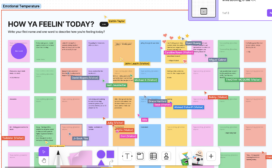UX Workshop Recap: Applying Design Thinking to AI
Artificial Intelligence (AI) is helping teams do more in less time. Manual tasks can now be automated. Complex data can be turned into insights to make predictions. And AI is impacting nearly all professions, including UX and product design.
SPR recently hosted a workshop, “Design Thinking for AI,” featuring guest speaker Rich Hultman, Sr. Innovation Designer at IBM. Rich covered why design thinking is important to AI projects and how the design team at IBM uses AI to help their business and sales teams implement the right products.
Among the insights shared, Rich covered the AI essential framework and where design thinking activities come into play.


The AI Essential Framework
Purpose: Determine the business purpose, anticipated value, and desired impact.
Research & Brainstorm: Use framing, discovery and solutioning sessions to brainstorm and collaborate on concepts that provide value to your business goal and your user’s intent.
Understanding: Map out the data during discovery and solution sessions. Identify data you have, what you need, and what is nice to have. Map the data points across Public, Private, and User-Centric.
Reasoning: Discuss, collaborate, and identify insights into the purpose. Data scientists, designers, technologists, and stakeholders work together to uncover current data and user behaviors.
Knowledge: Prioritize actionable artifacts as Primary, Secondary, and Tertiary layers of the AI.
AI models are meant to be trained. “Think about AI as a toddler,” Rich said. “We can’t just tell a toddler, ‘Go feed yourself, go catch the bus.’ There must be continuous monitoring and teaching.” With that in mind, there are six AI tenets to guide you.
Six Core AI Tenets
- Accelerate Research & Discovery: Process extensive data points to focus on the work that matters. Unstructured text becomes structured allowing researchers to look at the most critical insights.
- Enrich your interactions: Train AI on common requests to create efficiency.
- Anticipate and preempt disruptions: Continuously monitor the condition of your system to catch potential issues before they disrupt your work.
- Recommend, scale, and learn: Teach systems the nuances of your business by combining subject matter expertise. Add “humans in the loop” to improve and democratize content and “improve the humans.”
- Detect liabilities & mitigate risk: Train systems to understand and keep up with changing regulations and privacy obligations.
- Governed AI: Those with the privilege of creating AI systems are responsible for defining accurate, transparent, and ethical interactions that allow traceability.
Final Considerations
If you are conducting an AI Design Thinking workshop, consider these starter questions to kick off the brainstorming.
- Why are we doing this?
- How will we maintain the AI overtime?
- What can go wrong?
- How biased might the solution be?
- How do we protect user data?
- How will our AI use what it knows to meet our purpose?
Final words of advice? Keep a human involved with your AI application. You need ongoing human intellect involved with any AI because when AI goes awry, it’s because it didn’t understand the application.


